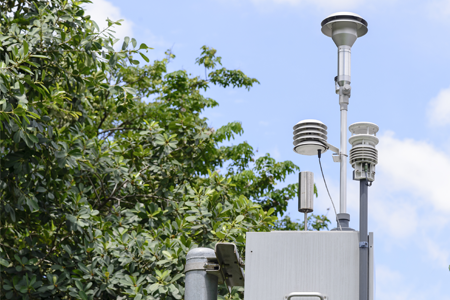
New local and regional air monitoring programs, supported by both public and private funding, have increased in recent years, driven in part by new interest in enhancing available information about local air quality across communities.
Opportunities and funding for community air monitoring initiatives are anticipated to significantly expand, particularly with the passage of the American Rescue Plan and the Inflation Reduction Act, which provide unprecedented levels of funding for local and community-based air monitoring projects.
- At the federal level, the U.S. Environmental Protection Agency (EPA) allocated $53.4 million for air monitoring initiatives in 2022 alone, with a focus on underserved and marginalized communities.
- More recently in November 2023, EPA’s new Community Change Grants program announced a $2 billion funding opportunity to support community-driven projects addressing environmental and climate justice challenges, including pollution monitoring and reduction.
Community air monitoring programs may focus on local air quality by measuring ambient concentrations of select pollutants in the air. In some cases, these initiatives are collaborative efforts, engaging local stakeholders and residents in program administration, which can contribute additional datapoints to broader air quality information for local neighborhoods.
The American Chemistry Council (ACC) appreciates efforts to advance scientifically robust air quality information collection and appropriate risk-based communications. And this is not new for our industry. For more than 20 years, ACC members have tracked and worked to continuously improve air emissions and environmental performance under Responsible Care®.
The end goals of any successful community air monitoring program should include:
- Producing scientifically defensible data that is accurate, quantifiable, verifiable and generated through the use of reliable air quality monitors or other comparable technologies that promote scientific integrity;
- Communicating results in an accessible, approachable format that prioritizes important contexts and proper risk characterizations for the data; and
- Enhancing engagement and buy-in from the community that the program is intended to serve in a clear and transparent way.
In the future, these types of efforts, if structured appropriately, can act as one datapoint to inform understanding about air quality in addition to separate comprehensive and scientifically robust existing programs.
This article provides an overview of some aspects of community air monitoring programs and how they can advance community goals and engagement, as well as examples of current community air monitoring initiatives and the role the chemical industry can play.
Designing a Community Air Monitoring Program
Community air monitoring programs can be designed in several ways and depend on many factors, including existing local/regional monitoring capabilities, community priorities, partnership opportunities and available funding, among others. Often, community air monitoring programs are designed to enhance existing monitoring capabilities and increase information about local air quality.
Other purposes for these programs include advancing Science, Technology, Engineering and Mathematics (STEM) education efforts through collaborations with schools, expanding scientific data quality and access, and addressing areas of community interest.
Tools for Measuring Air Quality
A variety of tools can be used to measure community ambient air quality. Air analyzers/ monitors or air sensors could be placed within the community, with the purpose of collecting real-time data on air pollutants and provide information to residents about the air quality in their specific location.
- Air analyzers/monitors use advanced techniques to detect and measure the concentration of pollutants in the air. They are generally subject to Quality Assurance/Quality Control (QA/QC) and are intended to verify and validate the accuracy of the data.
- Air sensors are typically smaller, lower-cost devices (compared to air analyzers/ monitors) that produce an electrical signal proportional to the concentration of the pollutant, which can then be read and interpreted by a connected device. As such, they are generally considered less accurate and do not produce as robust or credible forms of data as air analyzers/monitors. Indeed, data generated by sensors may only result in potential confusion about the actual state of air quality for a given area.
The exact equipment selected for a given program will depend on many factors, including data accuracy and detection methods, the specific features and capabilities needed to achieve the program’s intended purpose, QA/QC procedures and program budget, among others.
Environmental Justice Considerations
Understanding air quality is important, as it can have direct implications on both human health and the environment. Community air monitoring programs may help identify opportunities to evaluate and assess areas that may be disproportionately affected by air quality issues.
ACC members have a longstanding commitment to listen to and engage with our communities under Responsible Care. The 5 Pillars of ACC’s Commitment to Environmental Justice focus on:
- Enhancing community engagement;
- Driving safety and sustainability through Responsible Care;
- Enabling sound science;
- Promoting data integrity; and
- Supporting diversity, equity, inclusion and accessibility.
In certain circumstances, a participatory approach may help build trust and ownership. In doing so, community air monitoring programs may serve as one tool to address the needs and interests of communities.
Examples of Community Air Monitoring Initiative Partnerships
In 2019, ACC’s foundation awarded a $1 million grant to Harris County, Texas, to develop a community air quality monitoring initiative, including deployment of new equipment and protocols to support the county’s local Community Air Monitoring Program. Through this grant, Harris County expanded its state-of-the-art monitoring system that included mobile and stationary monitors to continuously track and evaluate air quality. Some of these monitors have been placed in lower-income areas that had not had access to air monitoring before, and all the data is made publicly available online to empower communities and help build public confidence in air quality information. ACC is working to build on Harris County’s early success, exploring ways to potentially develop similar initiatives in chemical manufacturing hubs across the country.
Chemical companies and product manufacturers also are investing in community air monitoring. For example, Gulf Coast Growth Ventures (GCGV), a joint venture between ExxonMobil and SABIC, has partnered with the University of Texas at Austin to support community monitoring in the Gregory-Portland area of Texas since 2020, with stations placed at different campuses within the local school district. From 2019 to 2023, ROCKWOOL, based in Jefferson County, W.Va., also funded an ambient air monitoring program based at schools that shared data on an online dashboard.
Although there is no one-size-fits-all approach, community air monitoring programs may serve as a useful datapoint in a broader understanding of air quality. By supporting scientifically-robust community air monitoring programs that generate data with strong integrity, the chemical industry can help support the advancement of risk- and evidence-based policy decisions that benefit stakeholders.
